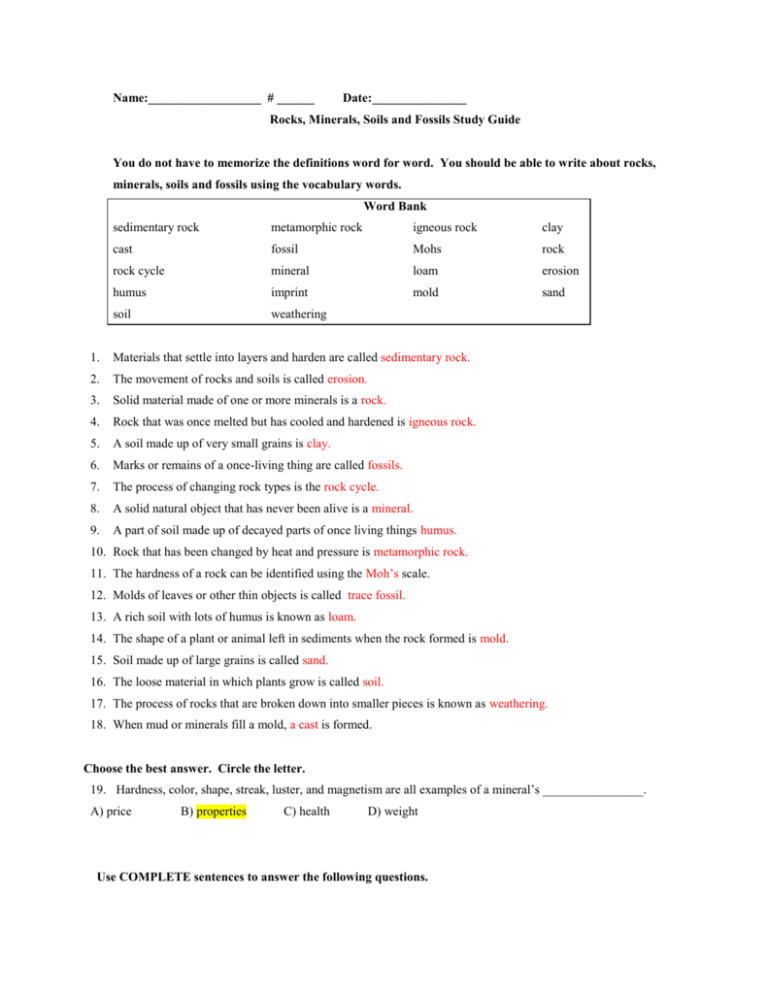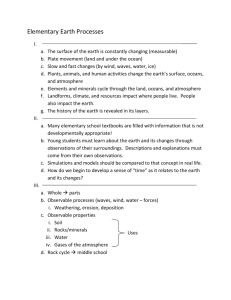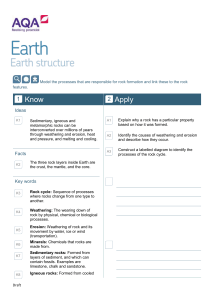Name: # ______ Date
advertisement

Name:__________________ # ______ Date:_______________ Rocks, Minerals, Soils and Fossils Study Guide You do not have to memorize the definitions word for word. You should be able to write about rocks, minerals, soils and fossils using the vocabulary words. Word Bank sedimentary rock metamorphic rock igneous rock clay cast fossil Mohs rock rock cycle mineral loam erosion humus imprint mold sand soil weathering 1. Materials that settle into layers and harden are called sedimentary rock. 2. The movement of rocks and soils is called erosion. 3. Solid material made of one or more minerals is a rock. 4. Rock that was once melted but has cooled and hardened is igneous rock. 5. A soil made up of very small grains is clay. 6. Marks or remains of a once-living thing are called fossils. 7. The process of changing rock types is the rock cycle. 8. A solid natural object that has never been alive is a mineral. 9. A part of soil made up of decayed parts of once living things humus. 10. Rock that has been changed by heat and pressure is metamorphic rock. 11. The hardness of a rock can be identified using the Moh’s scale. 12. Molds of leaves or other thin objects is called trace fossil. 13. A rich soil with lots of humus is known as loam. 14. The shape of a plant or animal left in sediments when the rock formed is mold. 15. Soil made up of large grains is called sand. 16. The loose material in which plants grow is called soil. 17. The process of rocks that are broken down into smaller pieces is known as weathering. 18. When mud or minerals fill a mold, a cast is formed. Choose the best answer. Circle the letter. 19. Hardness, color, shape, streak, luster, and magnetism are all examples of a mineral’s ________________. A) price B) properties C) health D) weight Use COMPLETE sentences to answer the following questions. 20. Why are more fossils found in sedimentary rocks than in other rocks (pages 116-117? Layers of sand and soil cover the once living thing. The object decomposes and a fossil remains. 21. How can sedimentary rocks become metamorphic rocks? Sedimentary rocks that have been changed by heat and pressure may turn into metamorphic rocks. You should be able to identify the rock cycle (pg 76). You should know the properties of a mineral (pg 58-59). You should know uses of rocks and minerals. You should understand the process and difference of weathering and erosion. You need to know how weathering changes the shape of rocks (pg 96-98). Also, know the difference between erosion and weathering. You should be able to understand the Mohs scale. A copy of the Mohs Scale will be provided on the test; however, you will have a list of minerals to put in order from hardest to softest. You need to know it takes thousands of years for rocks to change. A rock can not change into another type of rock in only 6 months.









